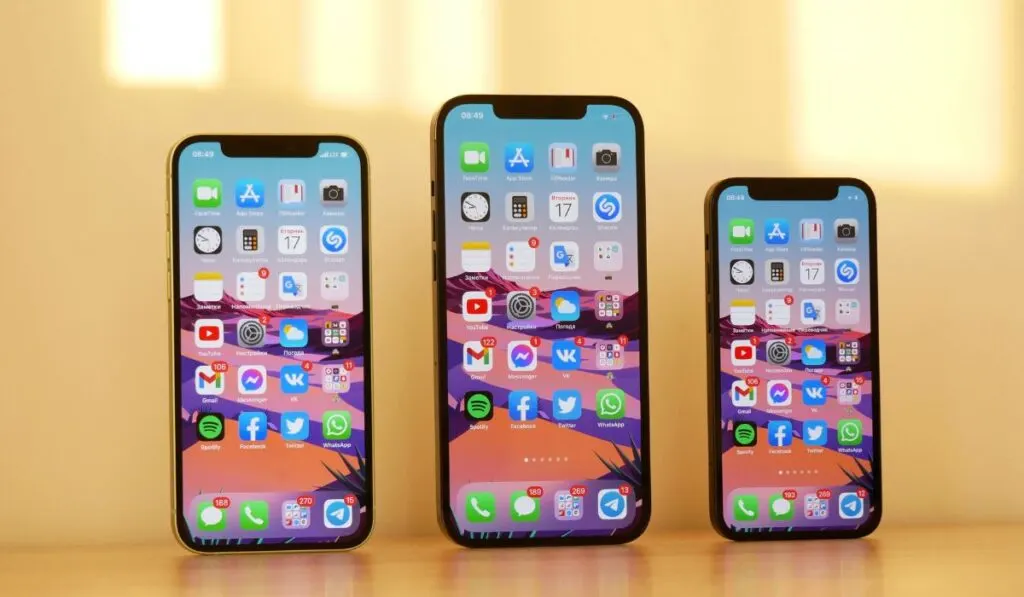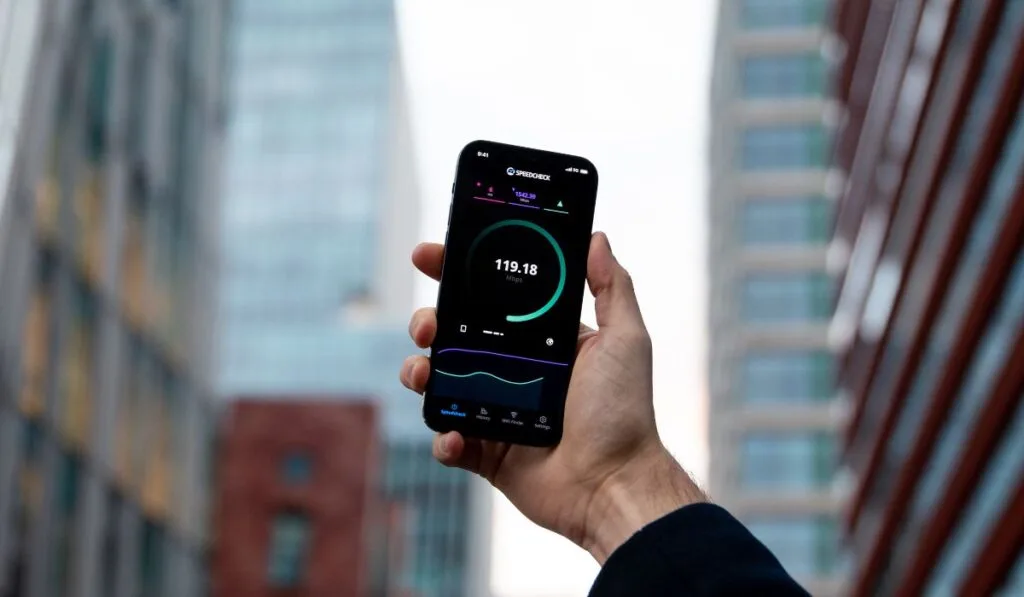You’ve probably heard that 5G technology will transform the way we use the internet with revolutionary improvements in data transfer speeds. But is 5G really effective? And which iPhones are 5G compatible?
All iPhones in the 12 and 13 series (and beyond) are 5G compatible, as well as the 3rd-Generation iPhone SE. But whether you’ll actually benefit from the much faster data transfer speeds offered by 5G depends on whether you live in an area where there’s high 5G coverage.
Now that you’ve got a general idea regarding which iPhones are 5G compatible, let’s take a closer look at how 5G works, which iPhones work with the technology, and whether you should consider getting a 5G-compatible iPhone.
What Is 5G?

5G is an acronym for “fifth generation internet,” which has better data transfer capabilities when compared to its predecessors 4G and 3G. The potential of 5G has been highlighted for many years, and the cutting-edge technology used in the 5G protocol can produce data transfer speeds significantly faster than those of other networks.
While high band 5G has the capacity to transfer data 1,000x faster than 4G bands, most 5G networks are actually only slightly faster than 4G. This is because most 5G networks use the lowest band version, which covers a larger area but doesn’t produce the same network speeds. So, if you’re looking to upgrade your 4G iPhone to 5G, it will not make much of a difference.
Nevertheless, even the lowest 5G band can significantly reduce data download and upload times.
That said, not all phone carriers offer 5G, and there are currently very few phone towers that support 5G in the US. Still, since the demand for faster internet has increased, more and more companies are offering 5G services.
How much you’ll benefit from 5G depends on the network quality offered by your service provider, how far you are away from the phone tower, and the 5G capabilities of your phone.
While it’s unlikely that you’ll get access to the best 5G bandwidth anytime soon, even the lowest 5G band can completely transform your data transfer experience.
How Do I Know if I Have 5G on My iPhone?
5G is only available on the latest iPhone models (on Amazon) from iPhone 12 and upwards. You can check for the 5G status symbol on your iPhone to see whether it can connect to a 5G network. However, even if your iPhone is compatible with 5G, you’ll still have to have a carrier that offers a 5G network plan.
If your iPhone has 5G compatibility, you’ll see the 5G, 5G+, 5Guw, or 5Guc symbols on your iPhone’s status bar. A simple 5G icon indicates that your phone has 5G and your carrier offers the low band version. If you see any of the other 5G symbols, it means your carrier offers a more advanced 5G connection.
It’s important to note that even if your iPhone has 5G capability, you’ll have to have a 5G plan, a network that supports 5G, and be in an area where 5G signals are available to actually use it on your phone.
5G-Compatible iPhones List

Currently, two iPhone series and the iPhone SE (as well as certain iPad models) support 5G. If you count all the phones in the iPhone 12 and 13 series, this makes around 9 iPhones that are 5G compatible. However, not all iPhones have the same level of 5G compatibility, and only certain models will work with all 3 5G bands.
Here’s the complete list of 5G compatible iPhones and their features:
iPhone 12
Features:
- Connects to both low band and mmWave length 5G
- Similar features to the iPhone 13 at a lower price
- 6.1-inch display, two 12MP rear cameras, and one 12 MP front camera
Available on Amazon for around $600.
iPhone 12 Pro
Features:
- Connects to both low and mid 5G bands
- High water resistance rating
- Up to 512 GB capacity
- HDR display with haptic touch
Available on Amazon for around $800.
iPhone 12 Pro Max
Features:
- Has full 5G capabilities
- 6.7-inch XDR display
- Has Telephoto, Wide, and Ultra Wide cameras
Available on Amazon for under $950.
iPhone 12 Mini
Features:
- Compatible with low, mid, and high 5G bands
- Smaller and lighter than other phones in the iPhone 12 series
- 5.4-inch display and dual camera capability
- Comes with a faster A14 Bionic processor
Available on Amazon for around $530.
iPhone 13
Features:
- Supports the faster C-band 5G
- Has a 6.1-inch display and three 12MP cameras
- Splash, water, and dust resistant
Available on Amazon for under $700.
iPhone 13 Pro
Features:
- Supports 5G from over 200 carriers
- Up to 1TB storage capacity
- 6.1-inch display with adaptive refresh rates
- IP68 Water resistance
Available on Amazon for around $900.
iPhone 13 Pro Max
Features:
- Compatible with both low and high band 5G signals, including the 5G NR band
- Larger 6.7-inch super retina XDR display
- Up to 1TB storage
- Dual e-SIM support
Available on Amazon for around $1,200.
iPhone 13 Mini
Features:
- Compatible with all 5G bands offered by network carriers
- Smaller 5.4-inch display
- IP68 water resistance with A15 Bionic processor chip
- Cheaper than other iPhone 13 models with most of the same features
Available on Amazon for under $600.
3rd-Generation iPhone SE
Features:
- Supports a wider range of 5G bands
- Has the same A15 Bionic chip as in the iPhone 13 range
- The smaller 4.7-inch display makes it the perfect pocket phone
- Comes with a 12MP rear camera and a 7MP front camera
Available on Amazon for around $380.
All these iPhones support 5G, although phones in the iPhone 13 series and the iPhone 3rd Generation SE support more 5G bands than those in the iPhone 12 series. However, even if your iPhone supports 5G, you’ll need a 5G plan from your carrier to benefit from the service.
How to Use 5G Options on Your iPhone
Even if your iPhone offers 5G, you don’t have to use it if you don’t notice any difference between 4G and the 5G that your current carrier offers. Fortunately, you can choose which 5G option to use based on your data plan, network speed, and phone battery life.
To access 5G options on your iPhone, open Settings and select ‘Cellular Data Options.’ From here, you can access data usage options, which data mode you want your iPhone to use, and data roaming options.
Voice and Data Options
On iPhones that support 5G, you’ll have the following data options:
- 5G Auto: This is the default 5G option, which allows your phone to instantly switch between data options based on the network speed and your phone’s battery situation. If the phone detects similar 4G and 5G speeds, it will switch on the 4G option to save battery life.
- LTE: If you choose the LTE option, the iPhone won’t use 5G, even if it’s available. You can use this when you need to preserve the phone’s battery or if your current carrier doesn’t offer a 5G plan.
- 5G On: When this option is selected, your phone will always use 5G, even if you aren’t getting better network speeds. Only select this option if you’re sure that your 5G plan provides consistently higher network speeds than any 4G option.
Overall, it’s best to keep the Auto option on for the perfect balance between faster data transfer and system optimization.
Managing Data Usage
One of the benefits of using 5G on the iPhone is that you can set data limits and choose how you want your phone to use the data. Under ‘Cellular Data Options‘ in cellular settings on your iPhone, select ‘Data Mode.’
Under this, you’ll see the following options:
Allow More Data on 5G
If your priority is to have faster internet, this feature is ideal. By selecting it, you’ll give your iPhone permission to maximize data usage through 5G on all apps and features that use the internet. This feature is ideal for updating apps, downloading large files, and streaming, and it allows you to get the full capacity of 5G on your phone.
While it does use more cellular data, having this feature active will give you better experiences in third-party apps. You can also turn it off in the WiFi settings when you have access to a fast WiFi connection.
Standard
This is the default setting on your iPhone and will only activate the cellular network for certain tasks. 5G will only be used for automatic updates and most other features will use standard data settings.
Data Roaming
If your carrier supports data roaming, you can connect to certain networks when traveling to get the same 5G experience as you would with your local carrier. However, this feature may have extra costs, so contact your network carrier if you need fast data transfer when traveling.
What About 5GE on iPhone?
If you use the AT&T carrier, you may see a “5GE” symbol on your iPhone, even if it’s not 5G compatible. However, 5GE is actually an enhanced version of 4G and isn’t a type of 5G band, as the name may lead you to believe.
Also, just because you see the 5GE icon after a recent iOS update, this doesn’t mean that it’s a new feature. If your iPhone was previously using 4G LTE on the network, you’ve probably already accessed the faster 4G version.
However, even this version of 4G is slower than the low-band 5G that most carriers offer. So, if you suddenly see a 5GE symbol instead of 4G, don’t get excited just yet. You may have a faster version of 4G, but it’s still not 5G!
Should You Get a 5G-Compatible iPhone?
Whether to get a 5G compatible iPhone depends on whether your local carriers offer 5G network plans, whether you live in an area with 5G towers nearby, and whether you actually need 5G. Not everyone needs extra fast internet, although it certainly can’t hurt!
On the one hand, 5G offers much better data transfer speeds, less network delay, and less network congestion. This means higher FPS for gaming, smooth video calls, and extremely fast downloads. It could also transform the way you use the internet at home or work.
On the other hand, the “perceived” benefits of 5G aren’t exactly what most carriers advertise since 5G is still being developed. Many users complain that 5G offers no noticeable difference in data transfer speeds and most carriers will only offer 5G with unlimited data plans. Most 5G compatible iPhones are also relatively expensive (although the 3rd-Generation iPhone SE is a more affordable option).
In the end, it all depends on the coverage you get from a 5G network in your area.
Where Is 5G Network Coverage Best?

The type of 5G coverage you’ll get depends on where you live and your network carrier. Most carriers in the US offer reliable 5G plans but T-Mobile, Verizon, AT&T, and Visible offer the best plans.
In terms of coverage, T-Mobile is the industry leader with 37% coverage. However, other network service providers are increasing their 5G coverage as the demand for 5G increases. The coverage is best in large metropolises and urban areas, so don’t expect 5G speeds if you live in a rural area.
